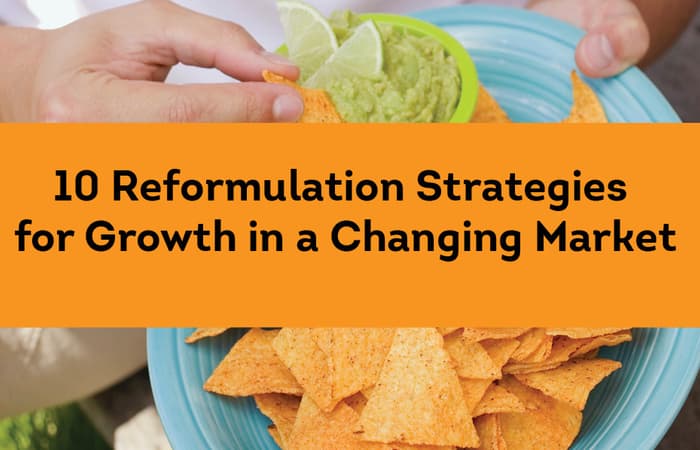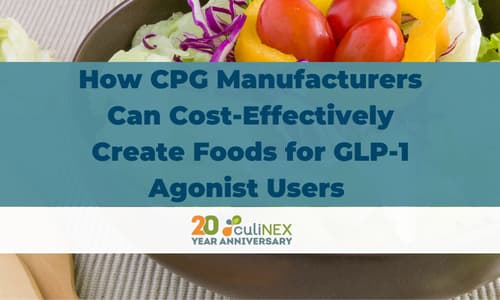
10 Reformulation Strategies for Growth in a Changing Market
From regulatory shifts to consumer trends, the changes in the food and beverage industry, consumer packaged goods (GPG) brands must constantly adapt in order to grow.
It’s time consuming and expensive to develop entirely new products. But there’s another way to respond to changes in the market that’s rapid, inexpensive, and accessible—reformulation. Reformulation is faster and more cost effective way to innovate. It allows brands to adapt, grow, stay ahead of the curve while retaining brand loyalty among your core customers.
CuliNEX has 20 years of experience in reformulation innovation for brands large and small. Here are ten reasons to reformulate your GPG brand with CuliNEX.
1. Regulatory Changes & Clean Label Trends
Regulations around food labeling and ingredient transparency continue to tighten globally. From updated nutrition facts requirements to allergen declarations and the rise of “natural” litigation, brands are increasingly prioritizing clean label reformulations. Consumers want simple, recognizable ingredients—and they’re reading labels more than ever. Reformulating with this in mind is no longer optional; it’s a competitive necessity.
Learn more: What California’s Ingredient Bans Mean For Brands
2. Consumer Palates Are Changing: Exotic, Flavorful, Convenient
Today’s consumers are craving bold, global flavors—but they don’t want to spend hours in the kitchen. There’s growing demand for meals and snacks that are both adventurous and easy to prepare or consume on-the-go. Reformulation provides an opportunity to tap into this trend by incorporating international ingredients, simplifying preparation methods, or adjusting texture and packaging formats.
Check it out: A Glimpse into the Future of Clean Label
3. The GLP-1 Effect: Appetite Suppression and Portion Sizes
With the widespread adoption of GLP-1 agonist drugs like Ozempic and Wegovy, consumer eating habits are shifting. Appetite suppression is leading to reduced portion sizes and a greater focus on nutrient-dense, satisfying foods. Brands should consider reformulating to deliver more flavor and nutrition per bite, potentially introducing smaller pack sizes or functional claims to meet evolving expectations.
Here’s How: How CPG Manufacturers Can Create Foods for GLP-1 Agonist Users
4. Cost Savings Through Smart Reformulation
In today’s economic climate, reducing cost without sacrificing quality is mission-critical. Reformulation can unlock real savings—by switching to more affordable ingredients, simplifying processes, or reducing over-engineered specs.
Take a Bite: Reformulating Chicken Tenders
5. Recession-Proofing Through Product Innovation
When wallets tighten, consumers become more price-sensitive—but they still demand value. Reformulating to reduce costs without compromising taste or nutrition allows brands to retain market share in downturns. Think comfort foods, pantry staples, and value packs. Affordable indulgence is key: products must feel worth the spend.
Case in Point: Bob Evans Farms Put a New Twist on Old Favorites.
6. Ingredient Supply Chain Disruptions & Global Uncertainty
Between tariffs, war-related trade restrictions, and supply bottlenecks, ingredient sourcing has become a rollercoaster. Reformulation offers resilience—allowing brands to substitute local or more stable alternatives when global uncertainty hits.
Bonus Idea: Reformulating Agility.
7. Co-Manufacturer Transitions & IP Ownership
Switching co-manufacturers is never plug-and-play. A common pain point? IP restrictions on existing formulas. We’ve seen clients reformulate products from the ground up—not for innovation, but to own the formula and enable multi-co-man flexibility.
Take Note: How to find the right Co-Manufacturer.
8. Plant-Based Protein Alternatives
With the plant-based movement still strong, reformulating to include legumes, grains, and novel protein sources is a growth strategy—especially when balancing taste, texture, and clean labels. This also supports broader claims around health and sustainability.
Deep Dive: Plant-Based Proteins Overview
9. Sustainability Claims & Reformulation
Brands increasingly want to make sustainability claims—lower carbon footprints, reduced water use, upcycled ingredients—but these often require reformulating to align with certifications or real impact data. It’s not just a marketing exercise; it’s a formulation challenge.
Get Inspired: Set sail for a Sustainable Food Future
10. Shelf Life & Preservation: Clean Label’s Toughest Challenge
One of the trickiest aspects of clean label reformulation is maintaining shelf life and food safety without synthetic preservatives. While many teams discuss it internally, published content remains scarce. There’s an opportunity here to lead the conversation—whether by trialing natural preservative systems, exploring HPP, or sharing real-world learnings.
Case Study: Brazi Bites Packaging From Shelf to Microwave
Final Thoughts
Reformulation can be a strategic lever that drives innovation, protects margins, and unlocks new growth for CPG food brands. Whether navigating ingredient disruptions, adapting to changing health trends, or moving toward sustainable sourcing, reformulation give you operational agility that lets you quickly respond to changing consumer trends. Want to dive deeper into any of these reformulation strategies or see a case study? Contact the team at CuliNEX.








